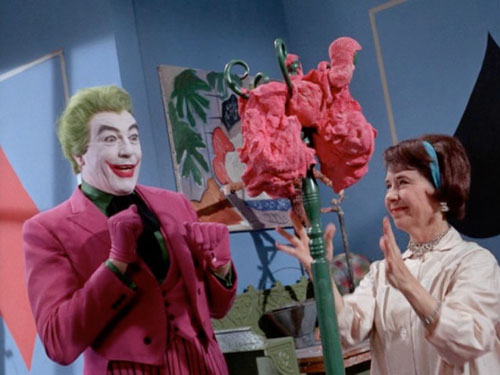About the final Joker story of season two:
Yikes. Eisner was correct about this episode marking the change in the Joker's portrayal; he's no more villainous than the "hoo-hoo-Haa-haa" animated version seen in
The New Scooby-Doo Movies (
"The Dynamic Scooby-Doo Affair" &
"The Caped Crusader Caper") from 1972. In other words, cringe-wrothy in how childish the Joker is in this arc. Compare him to the laughing with a sinister edge / strangling Batman version from his season one appearances. That was a fantastic Joker brought to life, and if not for the fact Romero was the actor wearing the same make-up & costume, this final season two Joker could be a completely different character.
Sad for the series that THE Batman villain above all others was reduced to the kind of silly character some fans skip over whenever they watch the series (I'm looking at you, Archer, Puzzler, Marsha, Lulu Schultz, Chandell, Louie, Dr. Cassandra, Minerva, et al.).
A few things...
Robin's "red blood" declaration (and similar remarks by Batman throughout the series) must be seen for what it was: a continuing reference to / play on the TV Batman being a
near stereotype of his comic book roots--a medium where the American hero often made grand proclamations about the integrity and granite-solid nature of his purpose, and/or entire being. The superhero genre had changed by the 1960s, but Dozier's
Batman was still channeling influences from its
early 20th century hero/comic foundation, where most creators meant exactly what the characters said regarding their identity, beliefs and purpose, with no hint of a double meaning.
That is one of the reasons the Dozier Batman felt like an unexpected, earth-shaking bolt of lightning on the TV and pop cultural landscape in 1966, because the characters and situations were so tied to a creative period considered dusty--long gone by 1966, but roared back--considered refreshing, in no small part due to the morally upright identity/beliefs of Batman/Wayne & Robin/Grayson, which were (and should be) taken at face value thanks to the characters' creative period origins.
Frankly, their allegedly "square" nature was one of the strongest draws to Dozier's series, as it was a great contrast to a mid 60s era already filled (if not littered) with morally/socially ambiguous protagonists, or "anti-hero." On that note, the "anti-hero" had arrived earlier than the oft-repeated and incorrect film historians' date of the decade's tail end, with Connery's James Bond, and others introduced at the
beginning of the 60s.
For some, there's a modern day tendency to see a series like
Batman as "subverting" all older character and story formats, but that's overreach, and considering the how and why the characters sold as presented touched a longing nerve, particularly in the American culture of 1966.
Oh, and about Marc Cushman's
Star Trek books. Skip them, as they are filled with wild assumptions, omissions and long-disproven stories that were once sold as "fact." For a more accurate assessment of
Star Trek, do yourself a BIG favor and browse
Star Trek Fact Check, where the academic analysis of all things from that original series are supported with the hard, cold truth of quotes, documents, supportive evidence and (what would even make Mr. Spock smile) logic--which is quite enjoyable, whether you're a
Star Trek fan or a serious TV historian.




